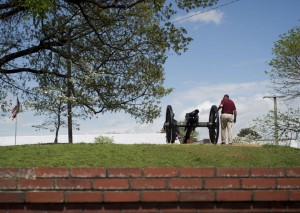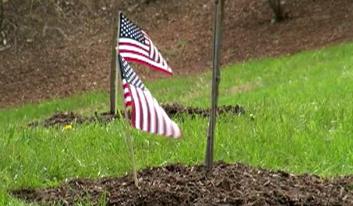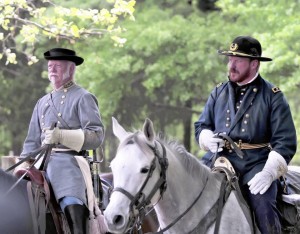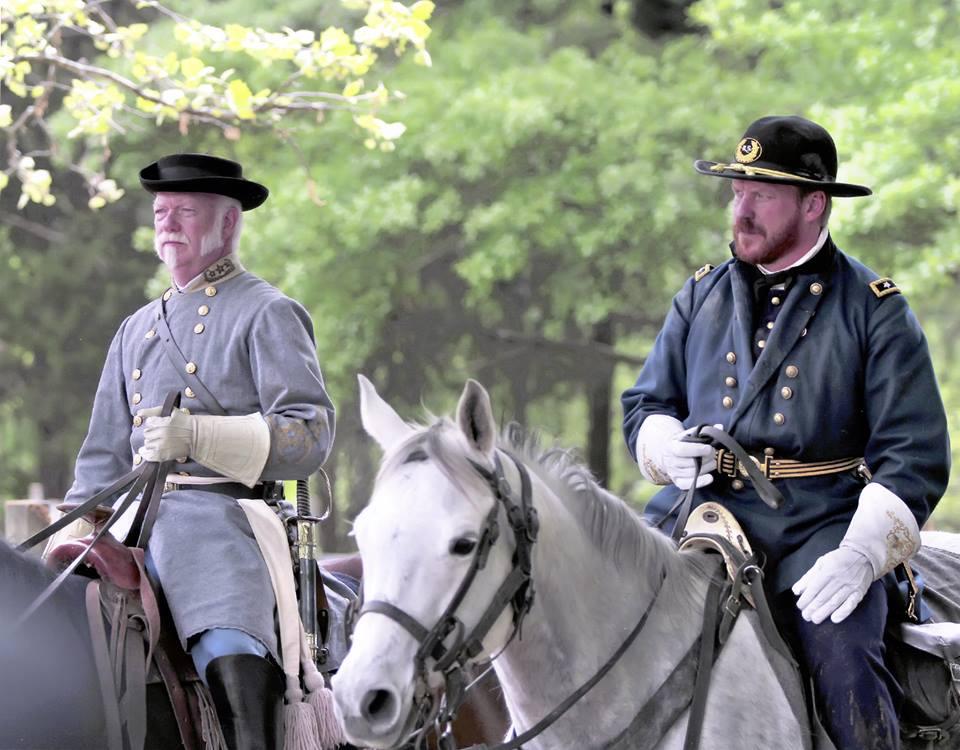GEORGIA: Civil War Ancestors Honored
Almost a century-and-a-half after the last shots were fired in the Civil War, soldiers who fought the battles were remembered in Van Zandt County on Saturday.
The family of Pvt. Elijah Hanks Woolverton hosted a memorial service and grave-marking ceremony at the Old Bethel Cemetery in Phalba.

Chaplain Jim Day of the Sons of Confederate Veterans Major Howdy Martin Camp 1241 in Athens honors the military service of the men from Texas who fought in the Civil War during a ceremony honoring veterans buried at the Old Bethel Cemetery in Phalba on Saturday. The event was hosted by descendants of Elijah Hanks Woolverton.
He died in 1924, but has numerous descendants in Van Zandt, Henderson, Anderson and surrounding counties. Woolverton was a member of the 11th Texas Infantry.
Jim Day, Chaplain of the Sons of Confederate Veterans Camp 1241 in Athens said the men who fought for the South felt it was their duty to serve their states in the conflict.
“If we do not honor our ancestors, we have no right to expect honor from our descendants,” Day said.
Camp 1241 Commander Jim Abney conducted the roll call of Confederate veterans buried in Van Zandt County, including 19 buried in the Old Bethel Cemetery.
Volleys of gun and cannon fire were sounded saluting the soldiers, most of which had come to Texas from parts of the South that were deeply involved in the fighting, Tennessee, Virginia, North Carolina, Alabama and Mississippi.
Terry Weems sounded “Taps” in their memory.
Prior to the ceremony, markers and small Confederate flags were placed by the graves of the veterans. Carrie Anne Woolverton explained that the flags were in the form of the original flag of the Confederate States of America, rather than the familiar “Stars and Bars.”
–athensreview.com
###
VIRGINIA: Restored Cannon Installed at Fort Early
LYNCHBURG, Va. — The defensive lines of historic Fort Early are once again armed for battle.
On Monday, crews installed a refurbished, Civil War-era cannon on the battleground where Confederate forces repelled a Union attack during the 1864 Battle of Lynchburg.
“What better place than Fort Early for a cannon,” said Randy Dalton of the Lynchburg Department of Public Works.

Randy Dalton, Construction Coordinator with Lynchburg City Public Works, helps install a civil war cannon on the front lawn of Fort Early. Photo by Jill Nance
The cannon, restored by Steen Cannons in Kentucky, was made in 1861 and was part of a set donated to the city by federal authorities in 1910.
The twin cannons stood in Miller Park for years, but their wooden carriage and wheels rotted over time, forcing them into storage by the 1980s.
One later was restored with new wooden fixtures and is on display at the Lynchburg Museum. The second cannon remained tucked away until five weeks ago when a rapidly organized fundraising campaign raised $16,000 to restore it.
“It’s a great visual,” Lynchburg Museum System Director Doug Harvey said of the cannon, which now stands on a high ridge at the edge of Fort Early, facing west where the Union forces would have gathered.
The cannon is a three-inch ordnance rifle, a popular model at the time for its accuracy and durability. To ensure it could withstand the elements, the barrel — which clocks in at about 900 pounds — was remounted on a replica carriage made of aluminum rather than wood.
“It should last 100-plus years,” Harvey said.
Officials were impressed by the swift response to the fundraising campaign spearheaded by the Lynchburg Historical Foundation in partnership with the city, the Lynchburg Museum Foundation and the Fort Hill Woman’s Club.
Supporters hoped to unveil the cannon in time for the sesquicentennial events at Appomattox Court House, but an earlier installation date last week was rained out.
The historic Fort Early is the only surviving example in the city of the earthen fortifications built by Confederate forces to protect strategic points.
It was here Confederate Gen. Jubal A. Early’s men opened fire — including use of several cannons — on the advancing forces of Gen. David Hunter in a battle that would end in a Union retreat the following day.
The full line of defense stretched all the way to Lynchburg College, Harvey said. The grounds at the corner of Fort and Memorial avenues are owned by the city and maintained as a historical attraction. The building on the property was constructed in 1923 and is owned by the Fort Hill Woman’s Club.
The new cannon is one of several upgrades the city has been making at Fort Early. In recent months, it’s spruced up the landscaping, posted a large new educational sign on Lynchburg’s Civil War history and moved two sandstone markers that used to be perilously close to the driveway.
Money left over from that work was put toward the cannon installation. The city paid for the wooden platform the cannon sits on and had Public Works add fortifications to ensure it won’t move.
Dalton, a construction coordinator for Public Works, said the chance to work on a historical project was a unique opportunity.
“I was saying this is one of the neatest things I’ve been involved with the city,” he said. “Hopefully, for years to come, I can ride by here and tell my grandkids, hey, I helped set that thing.”
IF YOU GO
Officials will hold an unveiling event for the new cannon display at 4 p.m. Tuesday, April 28 at Fort Early, corner of Fort Avenue and Memorial Avenue.
–newsadvance.com
###
VIRGINIA: Trees Planted to Honor Civil War Fallen
ORANGE, VA (NEWSPLEX) — During the Civil War, more than 600,000 people were killed or reported as missing in action.

The Virginia Nursery and Landscape Association is panting trees to honor each of the 600,000+ soldiers killed or missing in action during the Civil War.
Now a statewide organization is honoring those people by donating more than 600,000 trees, one for each person.
The Virginia Nursery and Landscape Association donated the trees to the Hallowed Grounds Living Legacy Project at a dedication ceremony held Monday at the Montpelier Train Station.
The ultimate goal is to create a living memorial for the fallen of the Civil War.
Cate Magennis-Wyatt, the founder of Journey Through Hallowed Grounds, said, “This is the end of the centennial of the Civil War and our partnership expands from Gettysburg to Monticello, we recognize that the soldiers who fell were never properly honored. So we have planted one tree for each of the 620,000 men who perished during the Civil War.”
The trees will be planted along the 180-mile long Journey Through Hallowed Ground National Scenic Byway, which runs from Gettysburg, Pennsylvania to Thomas Jefferson’s Monticello.
–newsplex.com
###
NORTH CAROLINA: Sherman, Johnston Re-Enact CSA Surrender
DURHAM — Re-enactors in the roles of Confederate Gen. Joseph E. Johnston and Union Gen. William Tecumseh Sherman on Sunday rode in on horseback from opposite sides of the field, mimicking what had happened exactly 150 years earlier — Johnston’s surrender of the CSA armies in the Carolinas, Georgia and Florida — at a farm in Durham.
The two generals had been fighting each other for years, but had never met in person before negotiations began on April 17, 1865, said Bob McKean, a volunteer at Bennett Place’s sesquicentennial commemoration.

Craig Braswell, as Gen. Joseph E. Johnston and John Guss, as Gen. William T. Sherman at Bennett Place in Durham.
CREDIT WWW.NCDCR.GOV
They both traveled by train on April 26, 1865. Johnston from Greensboro and Sherman from Raleigh. Upon arriving in what was then known as Durham Station, they needed a place to meet. They asked the Bennett family for use of their home on Hillsborough Road, sending the family of yeoman farmers to the kitchen to wait.
McKean said Hillsborough Road functioned as “the I-40 of the period.”
“That’s basically why this place got picked (for negotiations),” he said. “It was right along the main road.”
Inside the home, the generals puffed cigars by candlelight as they discussed the final terms of Johnston’s surrender. An agreement had been reached on April 18, but federal officials, reeling in the wake of President Abraham Lincoln’s assassination by John Wilkes Booth on April 15, had nixed the deal, saying it was too generous to the rebel troops.
On April 26, Sherman, backed by some100,000 troops camped in the Raleigh area and ready to advance on Durham and Chapel Hill, handed Johnston new surrender terms. Sherman, like Johnston, was eager to cut a deal to keep his troops from razing Raleigh, a city like others in North Carolina that had been spared the torch which his forces had wielded on his famed “March to the Sea.”
“North Carolina didn’t start this war; that’s why we’ve been lenient coming through it,” Sherman said.
Johnston offered to surrender some more than 89,000 troops across four rebel states — a far larger surrender than the 28,000-man Army of Northern Virginia that Gen. Robert E. Lee had surrendered to Union Gen. Ulysses S. Grant at Appomattox Court House in Virginia on April 9. Confederate President Jefferson Davis considered Johnston’s surrender an act of treason since he hadn’t been defeated in battle. He proceeded with the surrender despite Davis’ objections.
In the end, Johnston agreed with federal demands that Confederate soldiers abandon their arms, accept parole papers signed by both Union and Confederate generals and return home.
On Sunday, visitors lined up under ponchos and umbrellas to get photos of “Sherman” and “Johnston” as they approached the Bennett house.
McKean said that organizers of the commemoration weekend had been expecting around 4,000 visitors but that the rainy weather had taken a significant toll on that estimate.
But for many history lovers, getting a little damp didn’t matter.
Michael Hale Gray of Durham was the first in line Sunday morning to get a ticket to relive the surrender. He said he’s always loved history and was fortunate to be able to see such an important commemoration only a few miles from his house.
Gray took part in commemoration events all weekend, but he waited to see the surrender negotiations until Sunday because it was the true anniversary of the signing of the surrender papers.
Gray said he was impressed by the effort of the volunteers who pulled the weekend of events together and by the knowledge of the re-enactors, some 400 of whom turned out for the weekend at what is now Bennett Place State Historic Site.
“It’s just been an amazing journey,” he said of the weekend.
Gray hopes to become a re-enactor when he retires so that he can pass the history on to future generations.
For re-enactors participating in the sesquicentennial celebration, the mission was much the same.
Curt Cole of Duplin City, who was playing a Union soldier, said that almost everyone involved had ancestors who fought.
“It’s a way to make sure their sacrifices weren’t forgotten, on both sides,” he said.
The sacrifice over four years was great, said Mark Avery of Orlando, who was also playing a Union soldier. About 670,000 were killed, which would equate to about 10 million killed in the present era.
“You basically lost a whole generation,” he said.
AFTERMATH: The final days of Johnston and Sherman
Gen. Johnston, a career U.S. Army officer before the Civil War, had served in the Mexican-American War before joining the Confederate cause … After the war, Johnston eventually became a successful businessman, served a term in Congress and was commissioner of railroads during the administration of President Grover Cleveland. … He died of pneumonia on March 21, 1891 in Washington, D.C., after catching cold as an honorary pallbearer at age 84 at the bitterly cold Feb. 19, 1891 New York City funeral of the adversary who was to become a longtime friend, Gen. Sherman. … He famously refused to wear his hat at the funeral. When asked why, he replied famously: “If I were in his place and he were standing here in mine, he would not put on his hat.”
Johnston and Sherman had led troops on opposing sides during the First Battle of Bull Run on July 21, 1861.
Gen. Sherman succeeded Gen. Grant as Commanding General of the Army from 1869-83 upon Grant’s inauguration as president in 1869. Sherman led the U.S. Army’s efforts in the Indian Wars in the West until months before his January 1884 retirement from the army. He was proposed as a serious Republican presidential candidate in 1884, but he refused the suggestion, issuing the famed statement: “I will not accept if nominated and will not serve if elected.” … He authored a famed memoir and became a popular speaker famed for his generosity to the down-and-out veterans who’d served under his command. … Sherman died on Valentine’s Day, 1891 at his home in New York. He was 71.
–thetimesnews.com
###



